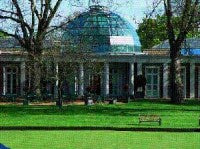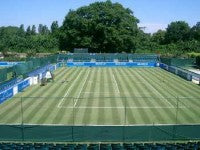The Hurlingham Club – Never a Dull Moment.
The Hurlingham Club - Never a Dull Moment
By Peter Craig

Since I was appointed Grounds Manager of the Hurlingham Club in November 1998 I have faced a tremendous variety of challenges, some expected and some that I hadn't faced before.
The Hurlingham Club is a very exclusive private members club in Fulham South West London. It is situated on the banks of the river Thames between Putney and Wandsworth bridges and as such is only a ten-minute car journey from the heart of the West End. And yet, once ensconced inside the forty two acres of beautiful grounds and gardens, it is impossible to imagine that you are anywhere near one of the biggest and busiest cities in the world.
The club boasts some of the highest quality indoor facilities seen anywhere with a 25 metre indoor heated pool, Jacuzzi, dance studio, treatment rooms, squash courts and a brand new state-of-the-art gymnasium. There is also a 25 metre heated outdoor pool, open during the summer months. Indoor banqueting facilities have recently been improved spectacularly with the building of a brand new building capable of staging functions for up to eight hundred people.
This building has a specially designed glass domed roof, designed and built in Switzerland and is a contemporary replica of a similar roof that was destroyed in the Second World War. The roof allows for the existence of eight live palm trees that give the building a wonderful tropical feel (even in the cold and wet of mid January!). The club also has a superb a-la-carte restaurant and two self-service eateries, several traditionally decorated "quiet" rooms for reading and a conservatory, which contains a variety of plants and shrubs, all of which are maintained by the gardening team.
Despite all these fantastic indoor facilities, the jewel in the crown of Hurlingham has always been the grounds and gardens.
The outdoor grass sport facilities comprise thirty grass tennis courts, ten full size croquet courts, two bowling greens and a cricket ground with a twelve-pitch square. We also have twenty two artificial tennis courts including three acrylic covered courts in our tennis "dome" There are also numerous ornamental lawn areas, all of which have to be presented to a very high standard.
Although the sports surface are a very important part of the club grounds, the incredible, and ever increasing variety of plants, shrubs and trees that make up the gardens are given equal billing in attention and budgeting terms.

We have over six hundred mature trees as well as a great number of young and newly planted specimens, all of which are monitored regularly and their condition entered in to an ever more detailed tree survey. We are currently working on a tree strategy to ensure that we continue to provide the variety and quality of treescape for the Hurlingham members of one hundred years hence.
So my role is to manage the team that cares for all these outdoor natural facilities. To this end I have a team of seven full time groundsmen and seven full time gardeners plus six seasonal groundsworkers (March to November) and four attendants whose job it is to keep the paths, roads, patios clean and tidy and ensure the bins are emptied etc.
On the gardens team I have a Head Gardener and Senior Gardener who are assisted by five other gardeners. We have had quite a high staff turnover in the gardening section of late, but in time it is likely that I will appoint a second senior gardener, probably a promotion from within the team. This will hopefully be someone showing real commitment and talent above and beyond that already very evident within a very good team.
Mike Batie, the Head Gardener is an exceptionally talented and highly committed gardener who has an even bigger problem than I do in not being able to "switch off" from work. Mike and his wife Helen who is a Senior Gardener here both have a house on site, as I do, and it is a common sight to find one or other of them out in the late evening, hand watering some of their precious plants.

None of the grass tennis courts, of which we have 30, were constructed for their current use. They are all simply areas of what 100 years ago were riverside fields that have been levelled and "converted" in to sports surfaces. This is the case for all 6 of the riverside croquet courts, however the 2 bowling greens were built as such although, like all the other surfaces, there are no man made drainage systems installed. This rarely presents a problem as the indigenous soil is an extremely free draining dark sandy loam all of which sits on top of an equally free draining sandy gravel.
On the croquet courts this combination has proved ideal although in the last two years we have been experiencing drainage problems on one of the lawns in particular. As you can imagine though, an open free draining soil is not ideal when trying to produce firm, fast and pacey grass tennis courts.
In an attempt to improve the binding qualities of the grass court soil I have been hollow tining and introducing a 12% (the indigenous clay content is under 6%) clay content loam to the courts. This has indeed improved the playing quality without reducing the after-rain playability of the courts, which is important as we do not cover them during wet weather.
The most serious sports-turf related problem I inherited when I arrived at Hurlingham was a layer of thatch on the grass courts which was up to 75mm deep in places! Whilst a vigorous scarification programme using Huxley tractor mounted scarifiers made some impression it was clear that more dramatic action was needed to eliminate this problem. Having watched the Koro topmaker in action at several venues, including centre court at Wimbledon courtesy of Eddie Seaward, I decided that the Koro was the answer and so four years ago we embarked on a programme, not of thatch reduction but one of thatch elimination on all the courts using the Koro.
I have been employing Norman Hollingsworth for all my Koroing operations and I cannot speak highly enough about Norman's operator skills and willingness to go that extra mile to make sure the job is done just right.
So we have now done 18 out of the 30 courts and hope to do 10 more this coming autumn. Regular in season thatch control and end of season thatch removal have changed the courts from spongy slow and low to firm and fast and it is now my intention to go back, "forth road bridge style", and fraze mow the grass courts on an annual basis once the initial thatch elimination has been completed next year.
The croquet courts are maintained in a very similar way to a golf green. We are currently beginning a comprehensive hollow coring and pure sand top dressing programme to improve sward composition, increase green speed and combat the aforementioned surface drainage problem. This work is being carried out under the expert eye of fellow Pitchcare team member David Whitaker. We started the programme in the spring and so far the results are very encouraging.
We have also recently purchased a 6 metre gator mounted sprayer and have started using liquid feeds and soil conditioners far more this season. We have again had excellent results and I am now looking into purchasing a chemical tank mixer which would be financed out of the savings made from purchasing soluble feeds rather than "brand" granular fertilisers.
We have also bought a "Big John" deep scarifier which we trialled last year and were very impressed with. This machine can penetrate well beyond the thin thatch layer we have on the croquet and bowls greens and is a further aid to the soil replacement programme being carried out on both the croquet/bowls and tennis courts.
We buy our tennis loam from Surrey Loams Ltd who have been supplying me with top class loams for over 20 years and buy our sand from Ruffords, that sand being their CH45 which is exactly the same sand as in our previously used top dressing but without the loam content.
The great attraction of my job is the tremendous variety of tasks that I am faced with.
A typical day could consist of a trip to Sainsburys to collect cat food for the yard cat, interviewing a prospective new employee, helping to adjust a machine, ordering parts, feeding the ducks, setting fox traps, meeting with the croquet, bowls, cricket, tennis committee, a 3 hour gardens and landscape committee meeting. I could go on…and on but I hope you get the idea.
The Hurlingham Club really is a unique place and the challenges it throws up to those who have to manage it are equally unique.
I thoroughly enjoy my job here and never underestimate how important the skill and endeavour of my team is in helping to produce what I hope is one of the best kept secrets of West London.
